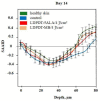In Vivo Quantification of the Effectiveness of Topical Low-Dose Photodynamic Therapy in Wound Healing Using Two-Photon Microscopy
- PMID: 35214020
- PMCID: PMC8877659
- DOI: 10.3390/pharmaceutics14020287
In Vivo Quantification of the Effectiveness of Topical Low-Dose Photodynamic Therapy in Wound Healing Using Two-Photon Microscopy
Abstract
The effect of low-dose photodynamic therapy on in vivo wound healing with topical application of 5-aminolevulinic acid and methylene blue was investigated using an animal model for two laser radiation doses (1 and 4 J/cm2). A second-harmonic-generation-to-auto-fluorescence aging index of the dermis (SAAID) was analyzed by two-photon microscopy. SAAID measured at 60-80 μm depths was shown to be a suitable quantitative parameter to monitor wound healing. A comparison of SAAID in healthy and wound tissues during phototherapy showed that both light doses were effective for wound healing; however, healing was better at a dose of 4 J/cm2.
Keywords: low-dose photodynamic therapy; photosensitizer; second-harmonic-generation-to-auto-fluorescence aging index of the dermis; two-photon microscopy; wound healing.
Conflict of interest statement
The authors declare no conflict of interest.
Figures











Similar articles
-
The In Vivo Quantitative Assessment of the Effectiveness of Low-Dose Photodynamic Therapy on Wound Healing Using Optical Coherence Tomography.Pharmaceutics. 2022 Feb 11;14(2):399. doi: 10.3390/pharmaceutics14020399. Pharmaceutics. 2022. PMID: 35214134 Free PMC article.
-
Quantitative Assessment of Low-Dose Photodynamic Therapy Effects on Diabetic Wound Healing Using Raman Spectroscopy.Pharmaceutics. 2023 Feb 10;15(2):595. doi: 10.3390/pharmaceutics15020595. Pharmaceutics. 2023. PMID: 36839917 Free PMC article.
-
Examination of wound healing after curettage by multiphoton tomography of human skin in vivo.Skin Res Technol. 2017 Nov;23(4):452-458. doi: 10.1111/srt.12355. Epub 2017 Mar 7. Skin Res Technol. 2017. PMID: 28271554
-
Positive effects of low-dose photodynamic therapy with aminolevulinic acid or its methyl ester in skin rejuvenation and wound healing: An update.J Biophotonics. 2023 Apr;16(4):e202200293. doi: 10.1002/jbio.202200293. Epub 2023 Jan 13. J Biophotonics. 2023. PMID: 36602479 Review.
-
Low-level laser therapy as an antimicrobial and antibiofilm technology and its relevance to wound healing.Future Microbiol. 2015;10(2):255-72. doi: 10.2217/fmb.14.109. Future Microbiol. 2015. PMID: 25689537 Review.
Cited by
-
Editorial on the "Special Issue in Honor of Dr. Michael Weber's 70th Birthday: Photodynamic Therapy: Rising Star in Pharmaceutical Applications".Pharmaceutics. 2022 Aug 26;14(9):1786. doi: 10.3390/pharmaceutics14091786. Pharmaceutics. 2022. PMID: 36145534 Free PMC article.
-
The In Vivo Quantitative Assessment of the Effectiveness of Low-Dose Photodynamic Therapy on Wound Healing Using Optical Coherence Tomography.Pharmaceutics. 2022 Feb 11;14(2):399. doi: 10.3390/pharmaceutics14020399. Pharmaceutics. 2022. PMID: 35214134 Free PMC article.
-
Evaluation of the effect of Matricaria recutita monotherapy or in combination with photodynamic therapy on tissue repair in the dorsum of the tongue of rats.J Appl Oral Sci. 2023 Oct 27;31:e20230211. doi: 10.1590/1678-7757-2023-0211. eCollection 2023. J Appl Oral Sci. 2023. PMID: 37909526 Free PMC article.
-
Non-invasive assessment of hair regeneration in androgenetic alopecia mice in vivo using two-photon and second harmonic generation imaging.Biomed Opt Express. 2023 Oct 19;14(11):5870-5885. doi: 10.1364/BOE.503312. eCollection 2023 Nov 1. Biomed Opt Express. 2023. PMID: 38021124 Free PMC article.
-
Quantitative Assessment of Low-Dose Photodynamic Therapy Effects on Diabetic Wound Healing Using Raman Spectroscopy.Pharmaceutics. 2023 Feb 10;15(2):595. doi: 10.3390/pharmaceutics15020595. Pharmaceutics. 2023. PMID: 36839917 Free PMC article.
References
-
- Zuhayri H., Knyazkova A.I., Nikolaev V.V., Borisov A.V., Kistenev Y.V., Zakharova O.A., Dyachenko P.A., Tuchin V.V. Study of Wound Healing by Terahertz Spectroscopy. In: Romanovskii O.A., Kistenev Y.V., editors. Proceedings of the Fourth International Conference on Terahertz and Microwave Radiation: Generation, Detection, and Applications; Tomsk, Russia. 17 November 2020; Tomsk, Russia: SPIE; 2020. p. 63.
-
- Beldon P. Basic Science of Wound Healing. Surg. Oxf. 2010;28:409–412. doi: 10.1016/j.mpsur.2010.05.007. - DOI
-
- Garcia J.G.M. Ph.D. Thesis. Univ. Manch; Manchester, England: 2015. The Role of Photodynamic Therapy in Wound Healing and Scarring in Human Skin.
Grants and funding
LinkOut - more resources
Full Text Sources

